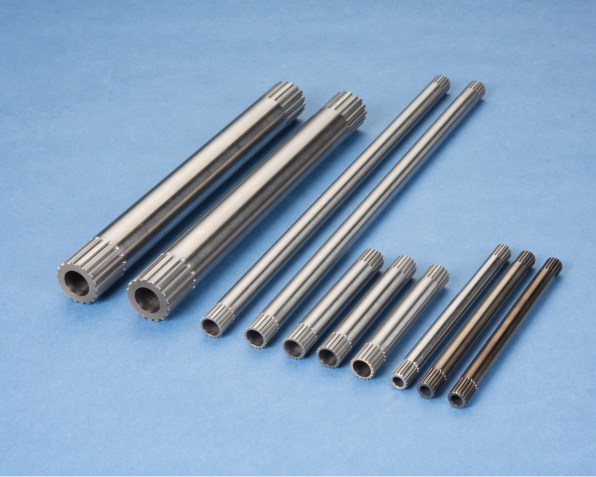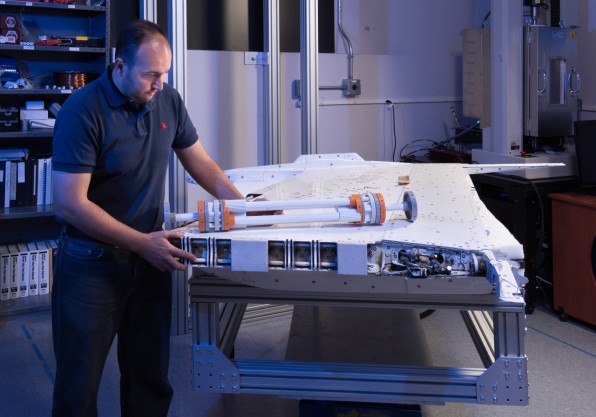NASA has created a lightweight shape-shifting metal that could be used to fold aircraft wings–which would allow planes to transform their wings for take-off, landing, and cruising, reducing drag, and making them more energy-efficient.
Last week, the agency launched a successful test on a drone outfitted with this metal, called a shape memory alloy, on the joints of its wings for the Spanwise Adaptive Wing project. These pieces of metal change shape when heated, and return to their former shape when cooled. “It’s like folding the bonds, instead of breaking the bonds,” explains Othmane Benafan, a materials scientist and co-principal at NASA’s Glenn Research Center. “Like folding paper, it’s reversible.” By having more control over the wings of the plane, pilots would be able to adjust the wings so they’re in the most efficient position and create the least amount of drag–which eats up fuel.
These shape-shifting alloys aren’t a new material–they were actually discovered in the late 1950s by chance, and have been used in the medical and aeronautical industries before. Benafan says you can even find them in household objects like dishwashers or toys.

Folding aircraft wings aren’t a new idea either, but they’re technically difficult. Previous versions of folding wings rely on conventional engines powered by hydraulics or electricity to change the shape of the aircraft during flight. But there are trade-offs–these machines are heavy and require power, which can offset the energy benefits of changing wing shape in the first place, and you can’t use them on small or delicate parts of the wing. Shape memory alloys, which are lightweight and don’t require a large engine to move, are a promising material that could truly make shape-shifting airplane wings more efficient.
This hadn’t been tried before because an alloy that would work didn’t yet exist. Previous alloys had low transformation temperatures–the temperature at which they would shift into their other shape. As a result, they might activate the wings of planes sitting on a hot tarmac–which could be dangerous and wreak havoc. You certainly don’t want the metal starting to shape-shift unless you tell it to. But NASA’s breakthrough was to create a strong alloy with a transformational temperature of 150 degrees Celsius. “You will never see that temperature accidentally on the tarmac,” Benafan says. “You’ll only get it when you command it to go to that temperature.”

To create the new metal combo, Benafan and his team started with the traditional combination for a shape memory alloy–nickel and titanium–and then slowly added different elements, studying what impact they had on raising the transformation temperature. Once they had a small sample that would only shift with a higher temperature, they were able to scale it up to create enough of the material to be feasible for production on an industrial scale. Then, Benafan and his team installed actuators made of their alloy onto a drone.
This drone is relatively small compared to a military or commercial jet. While the test was successful, there are more challenges ahead for the team. The alloy has only been tested in controlled environments and needs to undergo many more tests to ensure it can survive thunderstorms, hail, and the occasional bird for decades. The team also needs to find better, new ways to do the heating and cooling that will trigger the metal to change shape faster and more consistently. The last challenge will be to work with engineers so they understand how to integrate the material into future aircraft designs.
The team’s next step is to scale up their tests, and create actuators that work for a F18 fighter jet. These jets already have folding wings for when they land on aircraft carriers, but creating shape memory alloy mechanisms for those wings so they don’t need conventional folding machinery could make the planes lighter and more efficient.
There are applications in space as well. Benafan says that NASA is launching a satellite in March that will feature another type of shape memory alloy–also developed at Glenn Research Center–that has an even higher transformational temperature. The alloy actuators, when activated by the heat of the sun, will deploy and arrange solar panel arrays.
Read Again Watch This Plane's Wings Shapeshift, Thanks To NASA Tech : http://ift.tt/2DLL7Ks
Bagikan Berita Ini














0 Response to "Watch This Plane's Wings Shapeshift Thanks To NASA Tech"
Post a Comment